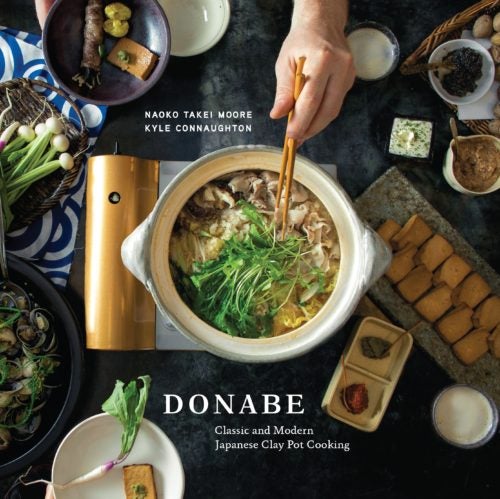

















Naoko Takei Moore and Kyle Connaughton explore recipes using a Japanese clay pot in Donabe.
With so many possible variations, it’s difficult to choose which rice recipes to share. This is a satisfying and relatively easy one that makes a complete meal with only a small amount of crabmeat. I like to make this dish on the Sonoma Coast of California, using local Dungeness crabs when they are in season; however, most varieties of crab will work just fine.
Buying whole crabs will yield you the shells and all the meaty flavors that come with them. The shells can be used to make the crab dashi, which can be used in place of water when cooking the rice to give a deeper, more complex umami flavor. The dashi instructions here make much more than the recipe requires, so you can enjoy the rest by trying the Hokkaido-Style Seafood-Miso-Kimchi Hot Pot or by serving it as a clear soup to accompany this dish. To make a soup from it, combine the dashi with just a bit of reserved crabmeat and a few of the tatsoi leaves, and add a sprinkle of salt, soy sauce, or shiro shoyu (white soy sauce).
Once you feel comfortable with he techniques in this dish, you can easily customize it to suit your tastes and the seafood you have on hand. We enjoy adding different typed of kimchi to this dish, as well as ginger, braised kombu, gingko nuts, mushrooms, and a variety of vegetables. – Kyle
Directions
- In the donabe, combine the rice with the water. (If you have made the crab dashi and have at least 3 1⁄4 cups, you can substitute 2 1⁄4 cups for the water here. Just make sure you have 1 cup left over to use later.) Let the rice soak for 20 minutes. Cover with both lids and cook over medium-high heat for 13 to 15 minutes. Turn off the heat and let it rest for 20 minutes.
- Meanwhile, working in batches, lay the green onions in a large dry sauté pan and char over medium-high heat, turning regularly, for 2 to 3 minutes. The green onions will begin to steam in their own moisture and char on the outside. Remove from the sauté pan and lay the green onions all facing the same direction on a cutting board. Trim the root end and a few inches of the green tops and discard. Slice the green onions into 1⁄4-inch rounds and reserve.
- Wipe out the sauté pan and heat the grapeseed oil over medium heat. Add the charred green onions and sauté for 1 minute, stirring frequently. Add the sesame oil and the mirin and scrape the pan to deglaze. Allow the alcohol to evaporate (1 to 2 minutes) and remove the pan from the heat. As the pan is cooling, swirl in the shiro shoyu. Set the green onions aside.
- Prepare a bowl of ice water and set aside. Bring a medium to large pot of salted water to a boil. Blanch the tatsoi leaves for 10 seconds and transfer the tatsoi immediately to the ice water. Once chilled, remove the leaves from the ice water, drain, and reserve.
- To finish the dish, fold the crabmeat into the rice (reserving some nice lump pieces for garnish), 1 cup of the crab dashi (or other dashi), the charred green onion mixture, the tatsoi leaves, and the toasted sesame seeds. Cover the rice cooker and gently heat over a medium flame for 3 to 4 minutes to heat thoroughly and perfume the rice with the crab aroma. Season with salt or additional soy sauce if desired, and garnish with the reserved lump crab pieces, additional sesame seeds, and ichimi togarashi.
- If using live crab, steam for 15 minutes, until cooked through, and then chill the whole crab before separating the meat from the shell. Chill thoroughly in an ice bath or the refrigerator. Clean the crab by separating the meat from the shells and reserve the meat. Remove any lungs, eyes, or apron using scissors, and discard. If you like a richly umami “sea flavor,” mix in any of the cooked brown sections of the crab with the meat, or keep them with the shells for a deeper-flavored stock. Reserve some of the nice lump pieces of meat for garnish on top of the final rice dish.
- In a medium pot, combine the reserved shells with the kombu and cover with the water. Heat gently and maintain the low heat below a simmer for 1 hour to infuse the crab and kombu into the stock. Remove the kombu and raise the heat slightly, still just below a simmer. Add the katsuobushi and turn off the heat. Steep for 5 minutes and strain through a fine-mesh sieve. Reserve 1 cup (240 ml) of strained stock for the final rice dish. Use the remaining stock to make a clear crab soup or for cooking the rice, if desired.
Reprinted with permission from Donabe, copyright © 2015 Naoko Takei Moore and Kylie Connaughton. Published by Ten Speed Press, an imprint of Penguin Random House LLC.

